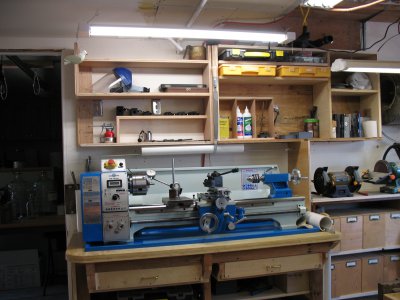- Joined
- Feb 17, 2016
- Messages
- 16
Hi fellow metal workers,
I got my new PM 1030 on Friday (3/11/16) and have it all set up and ready for testing.
The delivering trucker was kind enough to slide the lathe box off into my pickup bed. From there I worked it onto my table saw outfeed table. After unpacking it slid nicely across a temporary bridge to the waiting lathe bench. The lathe bench frame is made from some well-aged Douglas fir and the top is a couple of pieces of ¾” plywood glued and screwed together.
I was able to get it level all four ways within half an increment on a Starrett machinist level. I was a bit surprised to find all of the anchoring bolts on the center-line of the lathe. It seems like it would have been more stable and easily leveled if the anchor holes were spread out closer to the sides of the machine.
I checked the concentricity of the installed three-jaw chuck with my homemade dial indicator sled. It’s a scrap piece of 5/8 inch plate with a couple of pieces of high density plastic screwed to the bottom to protect the ways. The runout was under .001 (a pleasant surprise). The parallelism of the headstock to the bed also checked out well; about .001 per foot.
I’m anxious to start some actual turning but have to wait for bits from Victor Machinery and Mobile DTE oil from Zoro (the gearbox is pretty low)!
Best Pat
I got my new PM 1030 on Friday (3/11/16) and have it all set up and ready for testing.
The delivering trucker was kind enough to slide the lathe box off into my pickup bed. From there I worked it onto my table saw outfeed table. After unpacking it slid nicely across a temporary bridge to the waiting lathe bench. The lathe bench frame is made from some well-aged Douglas fir and the top is a couple of pieces of ¾” plywood glued and screwed together.
I was able to get it level all four ways within half an increment on a Starrett machinist level. I was a bit surprised to find all of the anchoring bolts on the center-line of the lathe. It seems like it would have been more stable and easily leveled if the anchor holes were spread out closer to the sides of the machine.
I checked the concentricity of the installed three-jaw chuck with my homemade dial indicator sled. It’s a scrap piece of 5/8 inch plate with a couple of pieces of high density plastic screwed to the bottom to protect the ways. The runout was under .001 (a pleasant surprise). The parallelism of the headstock to the bed also checked out well; about .001 per foot.
I’m anxious to start some actual turning but have to wait for bits from Victor Machinery and Mobile DTE oil from Zoro (the gearbox is pretty low)!
Best Pat

